Communication for Health Professionals
VerifiedAdded on 2022/10/31
|8
|2270
|307
AI Summary
This essay discusses the importance of communication in healthcare, especially for registered nurses. It evaluates the strategies for building a quality rapport with the patient and effective communication strategies such as verbal, non-verbal, written and interpersonal communication. The case study of Kirra Hawkins is used to illustrate the strategies and challenges. The essay also covers barriers to communication, ethical considerations, and referral of the patient to different specialists.
Contribute Materials
Your contribution can guide someone’s learning journey. Share your
documents today.
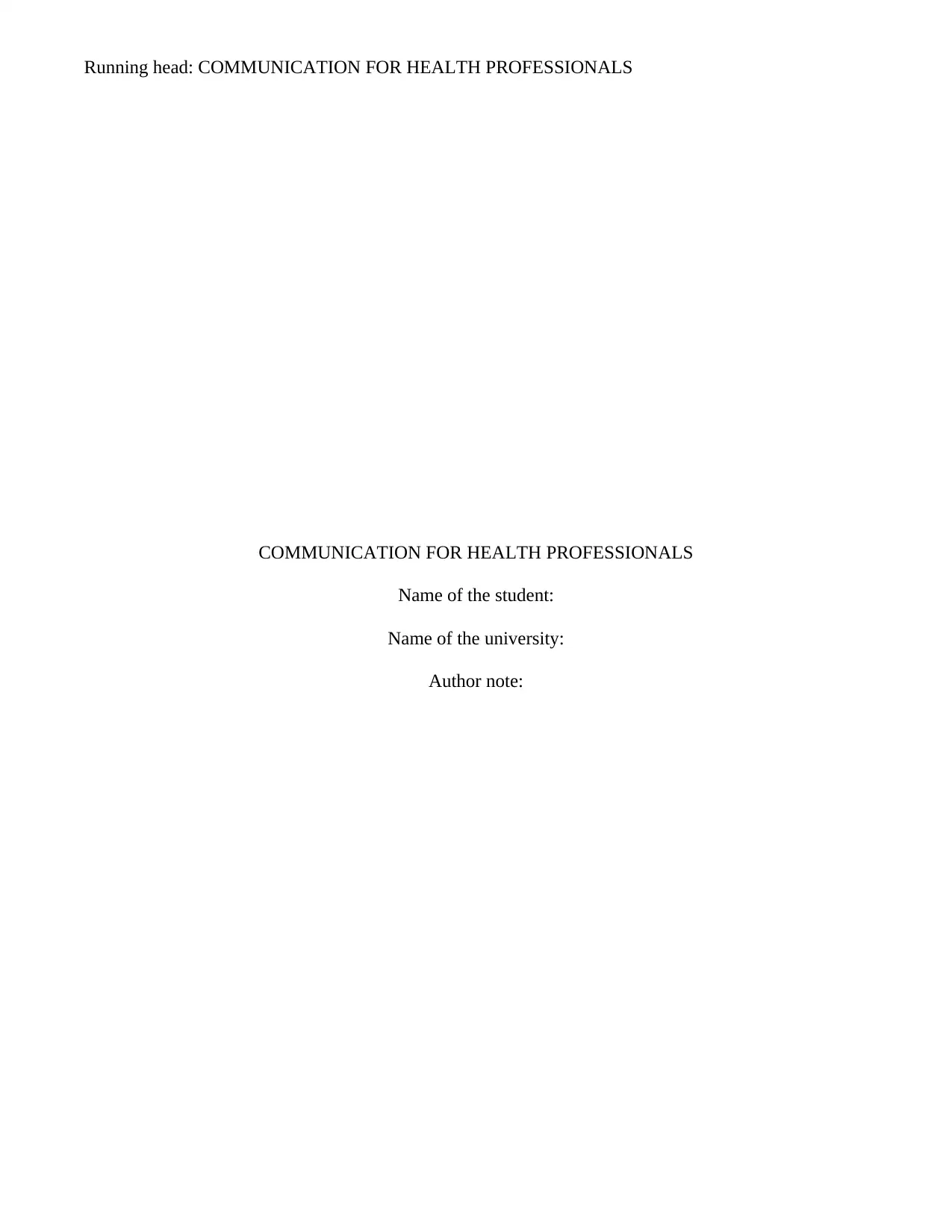
Running head: COMMUNICATION FOR HEALTH PROFESSIONALS
COMMUNICATION FOR HEALTH PROFESSIONALS
Name of the student:
Name of the university:
Author note:
COMMUNICATION FOR HEALTH PROFESSIONALS
Name of the student:
Name of the university:
Author note:
Secure Best Marks with AI Grader
Need help grading? Try our AI Grader for instant feedback on your assignments.
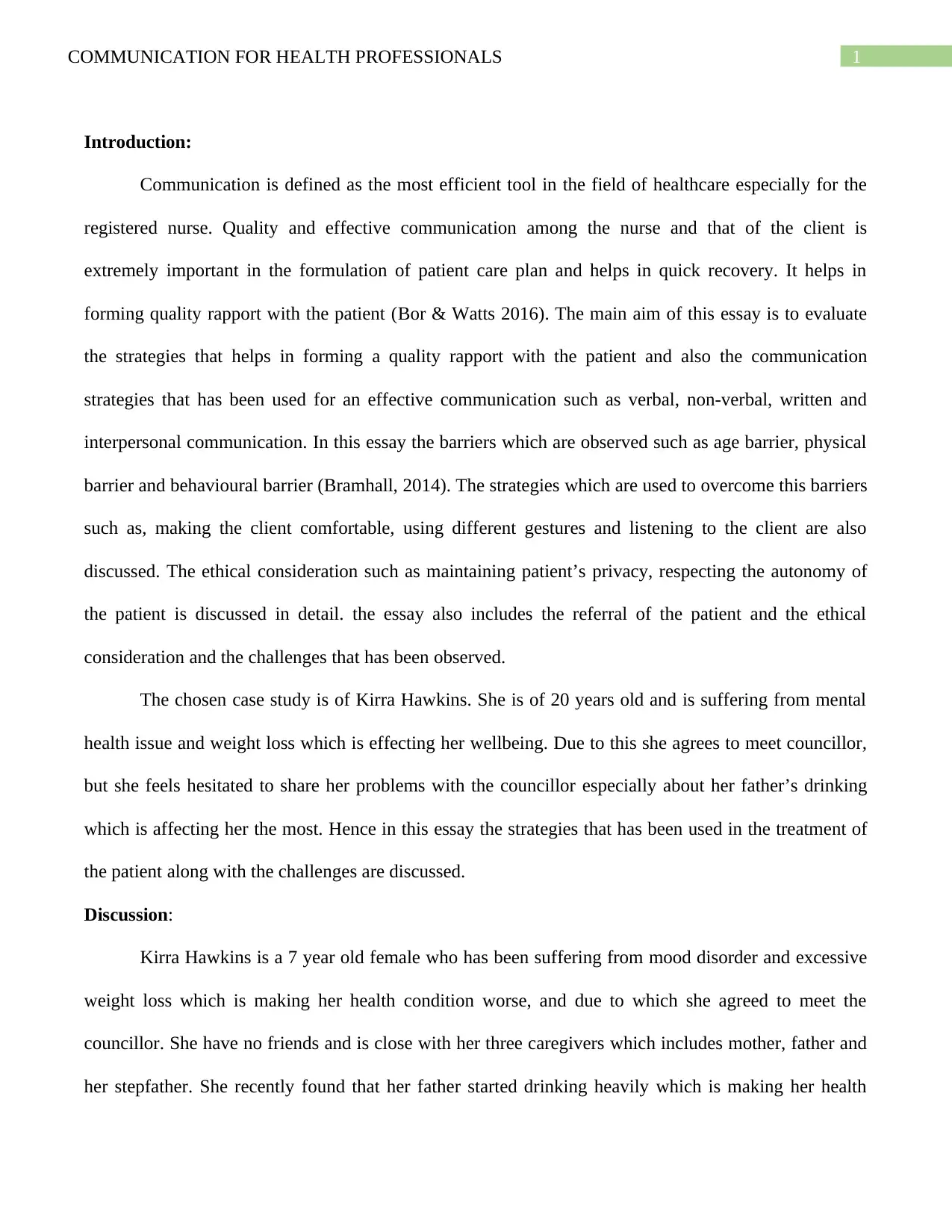
1COMMUNICATION FOR HEALTH PROFESSIONALS
Introduction:
Communication is defined as the most efficient tool in the field of healthcare especially for the
registered nurse. Quality and effective communication among the nurse and that of the client is
extremely important in the formulation of patient care plan and helps in quick recovery. It helps in
forming quality rapport with the patient (Bor & Watts 2016). The main aim of this essay is to evaluate
the strategies that helps in forming a quality rapport with the patient and also the communication
strategies that has been used for an effective communication such as verbal, non-verbal, written and
interpersonal communication. In this essay the barriers which are observed such as age barrier, physical
barrier and behavioural barrier (Bramhall, 2014). The strategies which are used to overcome this barriers
such as, making the client comfortable, using different gestures and listening to the client are also
discussed. The ethical consideration such as maintaining patient’s privacy, respecting the autonomy of
the patient is discussed in detail. the essay also includes the referral of the patient and the ethical
consideration and the challenges that has been observed.
The chosen case study is of Kirra Hawkins. She is of 20 years old and is suffering from mental
health issue and weight loss which is effecting her wellbeing. Due to this she agrees to meet councillor,
but she feels hesitated to share her problems with the councillor especially about her father’s drinking
which is affecting her the most. Hence in this essay the strategies that has been used in the treatment of
the patient along with the challenges are discussed.
Discussion:
Kirra Hawkins is a 7 year old female who has been suffering from mood disorder and excessive
weight loss which is making her health condition worse, and due to which she agreed to meet the
councillor. She have no friends and is close with her three caregivers which includes mother, father and
her stepfather. She recently found that her father started drinking heavily which is making her health
Introduction:
Communication is defined as the most efficient tool in the field of healthcare especially for the
registered nurse. Quality and effective communication among the nurse and that of the client is
extremely important in the formulation of patient care plan and helps in quick recovery. It helps in
forming quality rapport with the patient (Bor & Watts 2016). The main aim of this essay is to evaluate
the strategies that helps in forming a quality rapport with the patient and also the communication
strategies that has been used for an effective communication such as verbal, non-verbal, written and
interpersonal communication. In this essay the barriers which are observed such as age barrier, physical
barrier and behavioural barrier (Bramhall, 2014). The strategies which are used to overcome this barriers
such as, making the client comfortable, using different gestures and listening to the client are also
discussed. The ethical consideration such as maintaining patient’s privacy, respecting the autonomy of
the patient is discussed in detail. the essay also includes the referral of the patient and the ethical
consideration and the challenges that has been observed.
The chosen case study is of Kirra Hawkins. She is of 20 years old and is suffering from mental
health issue and weight loss which is effecting her wellbeing. Due to this she agrees to meet councillor,
but she feels hesitated to share her problems with the councillor especially about her father’s drinking
which is affecting her the most. Hence in this essay the strategies that has been used in the treatment of
the patient along with the challenges are discussed.
Discussion:
Kirra Hawkins is a 7 year old female who has been suffering from mood disorder and excessive
weight loss which is making her health condition worse, and due to which she agreed to meet the
councillor. She have no friends and is close with her three caregivers which includes mother, father and
her stepfather. She recently found that her father started drinking heavily which is making her health

2COMMUNICATION FOR HEALTH PROFESSIONALS
condition worse. She sometimes feel lonely and isolated and also stop doing her favourite activities such
as painting and drawing. She also wants to withdraw from her graduation degree which is bachelor in
fine arts. She does not feel comfortable in talking about her difficulties, especially related to her father’s
drinking.
Communication is extremely important in the field of healthcare as it helps in building a good
rapport with the patient. It assists in providing person centred and patient centred care to the patient
(Wosket, 2016). With the help of effective communication, patient feel more comfortable and their
feelings with the councillor without hesitating. kirra initially feels hesitated to share her feeling. Hence
in order to gather all the information necessary for the treatment of Kirra, it is necessary to make her feel
comfortable which can be only be achieved by building a good rapport with her (Dempsey, Reilly &
Buhlman, 2014).
The most effective strategies that is for maintaining a good rapport with the patient is listening
carefully. Carefully listening to the Ms Hawkins story one of the most important steps in building a
quality rapport with the patient before jumping to any conclusion. In order to maintain a rapport with the
patient, it is necessary to respect the patient and their decisions. Councillor should never judge the
patient. Another strategy is watching the speed of intimacy with the patient. As Kirra feels hesitated to
talk about her father, hence councillor should first talk about her friends, family, hobby, education and
then should go to her father. The patients is encouraged continuously to share her feelings and councillor
should also ensure her that it is helpful in her treatment (Dunn & Goodnight, 2016). The councillor
should use simple language in order to avoid any language barrier. Being competent is also important in
maintain a good rapport with the patient. If the councillor is not competent, the client is not going to
trust. Self-disclosure is also another way to build a good rapport with the patient, it can be considered as
one of the most efficient tool in gaining trust from the patient. If the councillor discloses their personal
condition worse. She sometimes feel lonely and isolated and also stop doing her favourite activities such
as painting and drawing. She also wants to withdraw from her graduation degree which is bachelor in
fine arts. She does not feel comfortable in talking about her difficulties, especially related to her father’s
drinking.
Communication is extremely important in the field of healthcare as it helps in building a good
rapport with the patient. It assists in providing person centred and patient centred care to the patient
(Wosket, 2016). With the help of effective communication, patient feel more comfortable and their
feelings with the councillor without hesitating. kirra initially feels hesitated to share her feeling. Hence
in order to gather all the information necessary for the treatment of Kirra, it is necessary to make her feel
comfortable which can be only be achieved by building a good rapport with her (Dempsey, Reilly &
Buhlman, 2014).
The most effective strategies that is for maintaining a good rapport with the patient is listening
carefully. Carefully listening to the Ms Hawkins story one of the most important steps in building a
quality rapport with the patient before jumping to any conclusion. In order to maintain a rapport with the
patient, it is necessary to respect the patient and their decisions. Councillor should never judge the
patient. Another strategy is watching the speed of intimacy with the patient. As Kirra feels hesitated to
talk about her father, hence councillor should first talk about her friends, family, hobby, education and
then should go to her father. The patients is encouraged continuously to share her feelings and councillor
should also ensure her that it is helpful in her treatment (Dunn & Goodnight, 2016). The councillor
should use simple language in order to avoid any language barrier. Being competent is also important in
maintain a good rapport with the patient. If the councillor is not competent, the client is not going to
trust. Self-disclosure is also another way to build a good rapport with the patient, it can be considered as
one of the most efficient tool in gaining trust from the patient. If the councillor discloses their personal
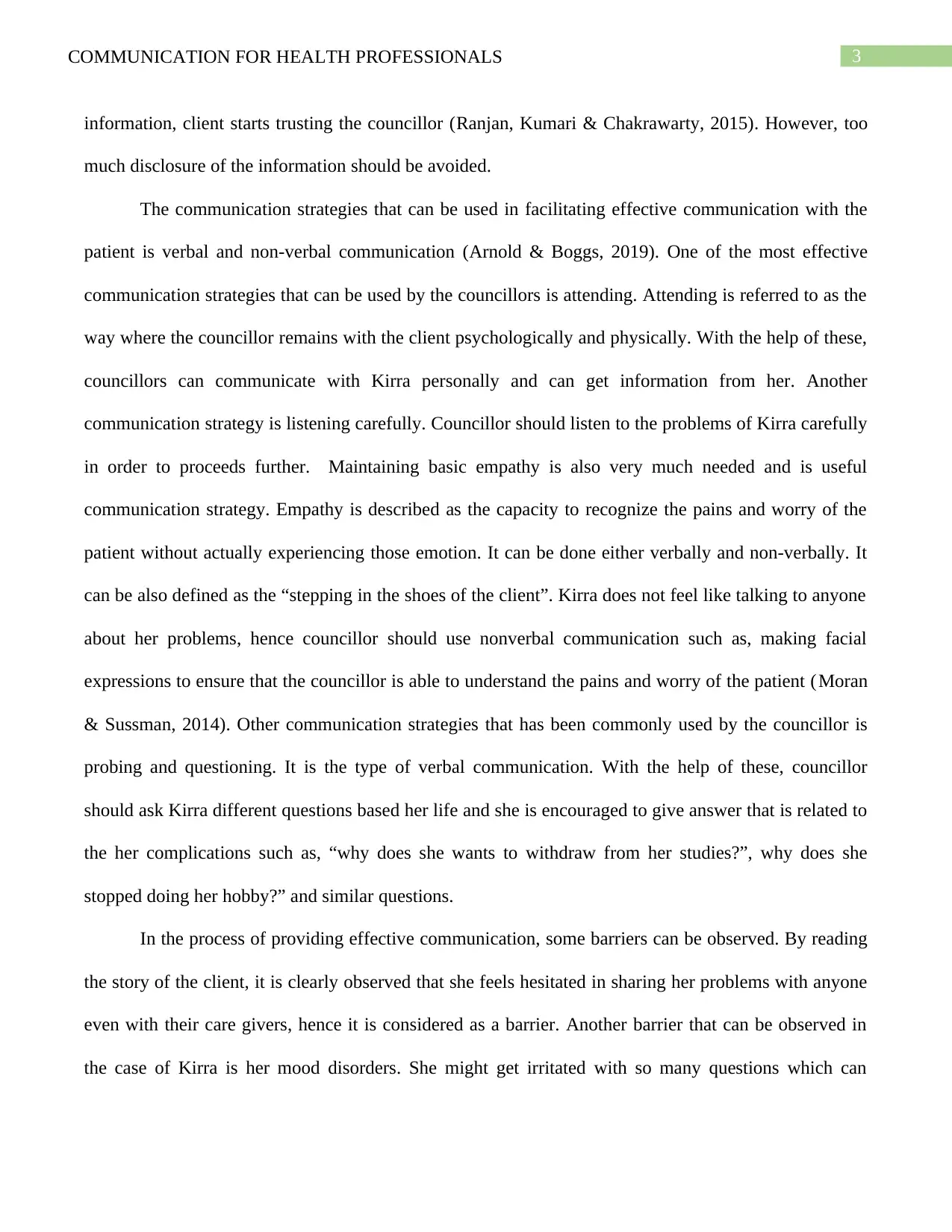
3COMMUNICATION FOR HEALTH PROFESSIONALS
information, client starts trusting the councillor (Ranjan, Kumari & Chakrawarty, 2015). However, too
much disclosure of the information should be avoided.
The communication strategies that can be used in facilitating effective communication with the
patient is verbal and non-verbal communication (Arnold & Boggs, 2019). One of the most effective
communication strategies that can be used by the councillors is attending. Attending is referred to as the
way where the councillor remains with the client psychologically and physically. With the help of these,
councillors can communicate with Kirra personally and can get information from her. Another
communication strategy is listening carefully. Councillor should listen to the problems of Kirra carefully
in order to proceeds further. Maintaining basic empathy is also very much needed and is useful
communication strategy. Empathy is described as the capacity to recognize the pains and worry of the
patient without actually experiencing those emotion. It can be done either verbally and non-verbally. It
can be also defined as the “stepping in the shoes of the client”. Kirra does not feel like talking to anyone
about her problems, hence councillor should use nonverbal communication such as, making facial
expressions to ensure that the councillor is able to understand the pains and worry of the patient (Moran
& Sussman, 2014). Other communication strategies that has been commonly used by the councillor is
probing and questioning. It is the type of verbal communication. With the help of these, councillor
should ask Kirra different questions based her life and she is encouraged to give answer that is related to
the her complications such as, “why does she wants to withdraw from her studies?”, why does she
stopped doing her hobby?” and similar questions.
In the process of providing effective communication, some barriers can be observed. By reading
the story of the client, it is clearly observed that she feels hesitated in sharing her problems with anyone
even with their care givers, hence it is considered as a barrier. Another barrier that can be observed in
the case of Kirra is her mood disorders. She might get irritated with so many questions which can
information, client starts trusting the councillor (Ranjan, Kumari & Chakrawarty, 2015). However, too
much disclosure of the information should be avoided.
The communication strategies that can be used in facilitating effective communication with the
patient is verbal and non-verbal communication (Arnold & Boggs, 2019). One of the most effective
communication strategies that can be used by the councillors is attending. Attending is referred to as the
way where the councillor remains with the client psychologically and physically. With the help of these,
councillors can communicate with Kirra personally and can get information from her. Another
communication strategy is listening carefully. Councillor should listen to the problems of Kirra carefully
in order to proceeds further. Maintaining basic empathy is also very much needed and is useful
communication strategy. Empathy is described as the capacity to recognize the pains and worry of the
patient without actually experiencing those emotion. It can be done either verbally and non-verbally. It
can be also defined as the “stepping in the shoes of the client”. Kirra does not feel like talking to anyone
about her problems, hence councillor should use nonverbal communication such as, making facial
expressions to ensure that the councillor is able to understand the pains and worry of the patient (Moran
& Sussman, 2014). Other communication strategies that has been commonly used by the councillor is
probing and questioning. It is the type of verbal communication. With the help of these, councillor
should ask Kirra different questions based her life and she is encouraged to give answer that is related to
the her complications such as, “why does she wants to withdraw from her studies?”, why does she
stopped doing her hobby?” and similar questions.
In the process of providing effective communication, some barriers can be observed. By reading
the story of the client, it is clearly observed that she feels hesitated in sharing her problems with anyone
even with their care givers, hence it is considered as a barrier. Another barrier that can be observed in
the case of Kirra is her mood disorders. She might get irritated with so many questions which can
Secure Best Marks with AI Grader
Need help grading? Try our AI Grader for instant feedback on your assignments.
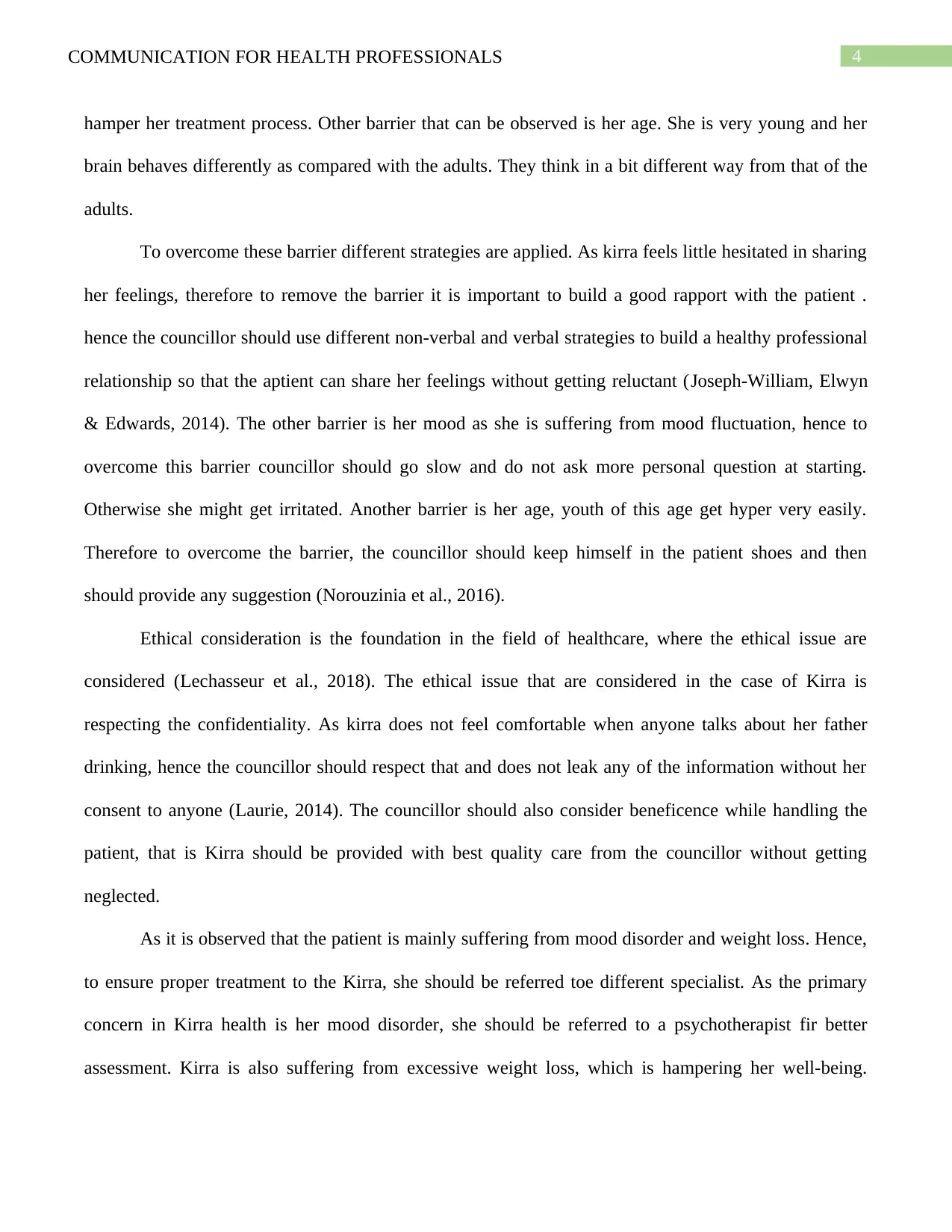
4COMMUNICATION FOR HEALTH PROFESSIONALS
hamper her treatment process. Other barrier that can be observed is her age. She is very young and her
brain behaves differently as compared with the adults. They think in a bit different way from that of the
adults.
To overcome these barrier different strategies are applied. As kirra feels little hesitated in sharing
her feelings, therefore to remove the barrier it is important to build a good rapport with the patient .
hence the councillor should use different non-verbal and verbal strategies to build a healthy professional
relationship so that the aptient can share her feelings without getting reluctant (Joseph-William, Elwyn
& Edwards, 2014). The other barrier is her mood as she is suffering from mood fluctuation, hence to
overcome this barrier councillor should go slow and do not ask more personal question at starting.
Otherwise she might get irritated. Another barrier is her age, youth of this age get hyper very easily.
Therefore to overcome the barrier, the councillor should keep himself in the patient shoes and then
should provide any suggestion (Norouzinia et al., 2016).
Ethical consideration is the foundation in the field of healthcare, where the ethical issue are
considered (Lechasseur et al., 2018). The ethical issue that are considered in the case of Kirra is
respecting the confidentiality. As kirra does not feel comfortable when anyone talks about her father
drinking, hence the councillor should respect that and does not leak any of the information without her
consent to anyone (Laurie, 2014). The councillor should also consider beneficence while handling the
patient, that is Kirra should be provided with best quality care from the councillor without getting
neglected.
As it is observed that the patient is mainly suffering from mood disorder and weight loss. Hence,
to ensure proper treatment to the Kirra, she should be referred toe different specialist. As the primary
concern in Kirra health is her mood disorder, she should be referred to a psychotherapist fir better
assessment. Kirra is also suffering from excessive weight loss, which is hampering her well-being.
hamper her treatment process. Other barrier that can be observed is her age. She is very young and her
brain behaves differently as compared with the adults. They think in a bit different way from that of the
adults.
To overcome these barrier different strategies are applied. As kirra feels little hesitated in sharing
her feelings, therefore to remove the barrier it is important to build a good rapport with the patient .
hence the councillor should use different non-verbal and verbal strategies to build a healthy professional
relationship so that the aptient can share her feelings without getting reluctant (Joseph-William, Elwyn
& Edwards, 2014). The other barrier is her mood as she is suffering from mood fluctuation, hence to
overcome this barrier councillor should go slow and do not ask more personal question at starting.
Otherwise she might get irritated. Another barrier is her age, youth of this age get hyper very easily.
Therefore to overcome the barrier, the councillor should keep himself in the patient shoes and then
should provide any suggestion (Norouzinia et al., 2016).
Ethical consideration is the foundation in the field of healthcare, where the ethical issue are
considered (Lechasseur et al., 2018). The ethical issue that are considered in the case of Kirra is
respecting the confidentiality. As kirra does not feel comfortable when anyone talks about her father
drinking, hence the councillor should respect that and does not leak any of the information without her
consent to anyone (Laurie, 2014). The councillor should also consider beneficence while handling the
patient, that is Kirra should be provided with best quality care from the councillor without getting
neglected.
As it is observed that the patient is mainly suffering from mood disorder and weight loss. Hence,
to ensure proper treatment to the Kirra, she should be referred toe different specialist. As the primary
concern in Kirra health is her mood disorder, she should be referred to a psychotherapist fir better
assessment. Kirra is also suffering from excessive weight loss, which is hampering her well-being.

5COMMUNICATION FOR HEALTH PROFESSIONALS
Therefore to improve the situation, she should be referred to dietician, where she will be provided with
suggestion, that is weight to eat and when to eat in order to maintain a quality life (Marcason, 2015).
There is no underlying medical condition observed, but then also it is important to examine to detect any
risk factors for any disease. For that she should be referred to a general physician.
Conclusion:
From the essay, it is concluded that the patient Kirra, is suffering from mood disorder and weight
loss. As Kirra feels hesitated to share her feelings, therefore it is necessary to build a good a rapport in
order to get all the information regarding her complications. To do so, different communication strategy
such as attending, empathy, verbal and nonverbal communication can be used. In the process of forming
professional relationship with the patient, different barriers such as, reluctance is observed, which can be
overcome by using different strategies. Different ethical consideration such as privacy, beneficence is
also discussed in the essay. At last the patient the patient is referred to different specialist such as
dietician, psychotherapist and physician for further treatment.
Therefore to improve the situation, she should be referred to dietician, where she will be provided with
suggestion, that is weight to eat and when to eat in order to maintain a quality life (Marcason, 2015).
There is no underlying medical condition observed, but then also it is important to examine to detect any
risk factors for any disease. For that she should be referred to a general physician.
Conclusion:
From the essay, it is concluded that the patient Kirra, is suffering from mood disorder and weight
loss. As Kirra feels hesitated to share her feelings, therefore it is necessary to build a good a rapport in
order to get all the information regarding her complications. To do so, different communication strategy
such as attending, empathy, verbal and nonverbal communication can be used. In the process of forming
professional relationship with the patient, different barriers such as, reluctance is observed, which can be
overcome by using different strategies. Different ethical consideration such as privacy, beneficence is
also discussed in the essay. At last the patient the patient is referred to different specialist such as
dietician, psychotherapist and physician for further treatment.
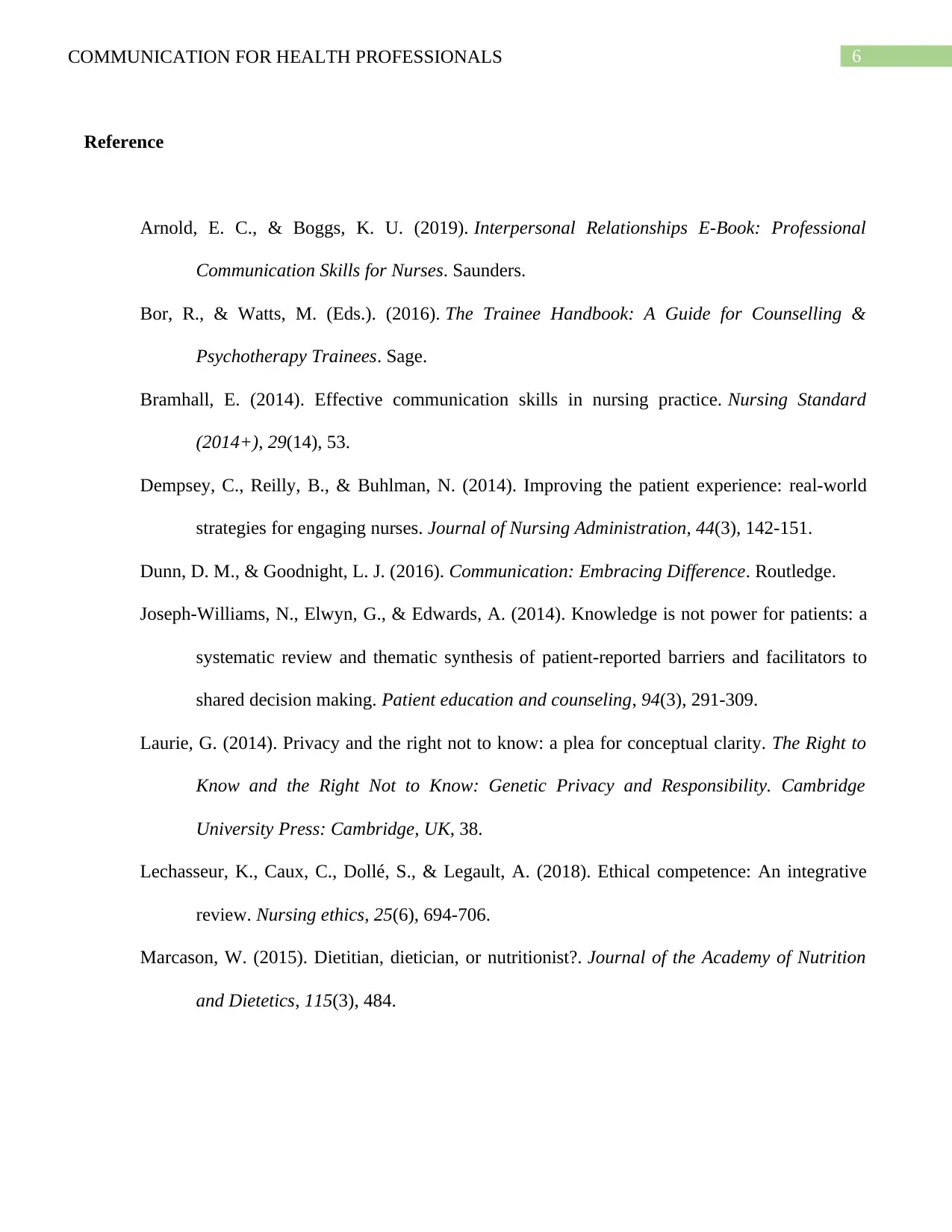
6COMMUNICATION FOR HEALTH PROFESSIONALS
Reference
Arnold, E. C., & Boggs, K. U. (2019). Interpersonal Relationships E-Book: Professional
Communication Skills for Nurses. Saunders.
Bor, R., & Watts, M. (Eds.). (2016). The Trainee Handbook: A Guide for Counselling &
Psychotherapy Trainees. Sage.
Bramhall, E. (2014). Effective communication skills in nursing practice. Nursing Standard
(2014+), 29(14), 53.
Dempsey, C., Reilly, B., & Buhlman, N. (2014). Improving the patient experience: real-world
strategies for engaging nurses. Journal of Nursing Administration, 44(3), 142-151.
Dunn, D. M., & Goodnight, L. J. (2016). Communication: Embracing Difference. Routledge.
Joseph-Williams, N., Elwyn, G., & Edwards, A. (2014). Knowledge is not power for patients: a
systematic review and thematic synthesis of patient-reported barriers and facilitators to
shared decision making. Patient education and counseling, 94(3), 291-309.
Laurie, G. (2014). Privacy and the right not to know: a plea for conceptual clarity. The Right to
Know and the Right Not to Know: Genetic Privacy and Responsibility. Cambridge
University Press: Cambridge, UK, 38.
Lechasseur, K., Caux, C., Dollé, S., & Legault, A. (2018). Ethical competence: An integrative
review. Nursing ethics, 25(6), 694-706.
Marcason, W. (2015). Dietitian, dietician, or nutritionist?. Journal of the Academy of Nutrition
and Dietetics, 115(3), 484.
Reference
Arnold, E. C., & Boggs, K. U. (2019). Interpersonal Relationships E-Book: Professional
Communication Skills for Nurses. Saunders.
Bor, R., & Watts, M. (Eds.). (2016). The Trainee Handbook: A Guide for Counselling &
Psychotherapy Trainees. Sage.
Bramhall, E. (2014). Effective communication skills in nursing practice. Nursing Standard
(2014+), 29(14), 53.
Dempsey, C., Reilly, B., & Buhlman, N. (2014). Improving the patient experience: real-world
strategies for engaging nurses. Journal of Nursing Administration, 44(3), 142-151.
Dunn, D. M., & Goodnight, L. J. (2016). Communication: Embracing Difference. Routledge.
Joseph-Williams, N., Elwyn, G., & Edwards, A. (2014). Knowledge is not power for patients: a
systematic review and thematic synthesis of patient-reported barriers and facilitators to
shared decision making. Patient education and counseling, 94(3), 291-309.
Laurie, G. (2014). Privacy and the right not to know: a plea for conceptual clarity. The Right to
Know and the Right Not to Know: Genetic Privacy and Responsibility. Cambridge
University Press: Cambridge, UK, 38.
Lechasseur, K., Caux, C., Dollé, S., & Legault, A. (2018). Ethical competence: An integrative
review. Nursing ethics, 25(6), 694-706.
Marcason, W. (2015). Dietitian, dietician, or nutritionist?. Journal of the Academy of Nutrition
and Dietetics, 115(3), 484.
Paraphrase This Document
Need a fresh take? Get an instant paraphrase of this document with our AI Paraphraser

7COMMUNICATION FOR HEALTH PROFESSIONALS
Moran, M. B., & Sussman, S. (2014). Translating the link between social identity and health
behavior into effective health communication strategies: An experimental application
using antismoking advertisements. Health communication, 29(10), 1057-1066.
Norouzinia, R., Aghabarari, M., Shiri, M., Karimi, M., & Samami, E. (2016). Communication
barriers perceived by nurses and patients. Global journal of health science, 8(6), 65.
Ranjan, P., Kumari, A., & Chakrawarty, A. (2015). How can doctors improve their
communication skills?. Journal of clinical and diagnostic research: JCDR, 9(3), JE01.
Wosket, V. (2016). The therapeutic use of self: Counselling practice, research and supervision.
Routledge.
Moran, M. B., & Sussman, S. (2014). Translating the link between social identity and health
behavior into effective health communication strategies: An experimental application
using antismoking advertisements. Health communication, 29(10), 1057-1066.
Norouzinia, R., Aghabarari, M., Shiri, M., Karimi, M., & Samami, E. (2016). Communication
barriers perceived by nurses and patients. Global journal of health science, 8(6), 65.
Ranjan, P., Kumari, A., & Chakrawarty, A. (2015). How can doctors improve their
communication skills?. Journal of clinical and diagnostic research: JCDR, 9(3), JE01.
Wosket, V. (2016). The therapeutic use of self: Counselling practice, research and supervision.
Routledge.
1 out of 8
Related Documents
Your All-in-One AI-Powered Toolkit for Academic Success.
+13062052269
info@desklib.com
Available 24*7 on WhatsApp / Email
![[object Object]](/_next/static/media/star-bottom.7253800d.svg)
Unlock your academic potential
© 2024 | Zucol Services PVT LTD | All rights reserved.




